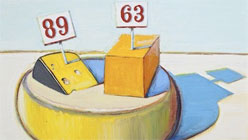On the second floor of an old public building located next to the Piazza Maggiore in Bologna, one can find the Museo Morandi, a dignified and modest exhibition space that is devoted to the work of Giorgio Morandi (1890-1964). Morandi has been widely regarded as the most important Italian painter of the twentieth century, an assertion that was confirmed by a major retrospective devoted to his work at the Metropolitan Museum of Art in 2008. That exhibition garnered both praise and interest because of the way that the deeply considered, quiet, and introspective character of the Bolognese master’s work seemed to be such a welcome and uncanny retort to the noisy spectacle of contemporary-art-as-we-know-it.
Morandi lived and worked all his life in Bologna, where, for many years, he taught etching at that city’s Accademia di Belle Arti. Although he made frequent visits to nearby Venice and Florence, in his latter years, he was something of a recluse. Now, over four decades after his death, his oddly eccentric still life compositions still attest to the fact that his legacy as the reigning master of painterly understatement and complex formal subtlety is fully intact. In so many ways, Morandi was a true painter’s painter, deeply ensconced in Italian art history. He was deeply aware of the crucial role that evocations of light and atmosphere play in slowing the viewer’s gaze to the point where pictorial nuance becomes the locus for an aesthetics of deep meditation.
Recently, the Museo Morandi invited Wayne Thiebaud to exhibit fifteen smaller works alongside eleven by Morandi in two of its intimate galleries. The exhibition was curated by Alessia Masi with Carla Crawford and is designed to set up close side-by-side comparisons between the two artists. For example, one of Morandi’s trademark groupings of humble crockery paired with geometrically skewed blocks of cheese in a 1956 painting simply titled Natura morta is set up next to one of Thiebaud’s signature works titled Cheese Wedges (2011). The latter work shows blocks of cheese set on a deli counter with plastic price tags affixed to them. In another instance, one of Thiebaud’s landscape paintings of the Sacramento River delta from the late 1980s is positioned next to one of the landscapes that Morandi painted during the single year that he fled Bologna (1944) owing to the danger posed by nearby military hostilities. The works by Thiebaud exemplify all phases of his long career, and almost all of the works in this exhibition are small, making for intimate visual encounters that seduce a viewer’s eye. Generally, such pairings seem focused on similarities of subject matter, but there are also some obvious formal similarities, such as the backgrounds formulated out of almost flat color that isolate the foreground objects amid intentionally indistinct environments.
The real interest provoked by this exhibition lies in how it reveals the differences between the two painters, and by this, I do not mean that it stages any competitive confrontation, only a very intelligent contrast of sensibility and pictorial priority. Clearly, the most noticeable of these differences is color, and this alone could be the subject of a long philosophical essay. Thiebaud’s color is richly informed by the late modern chromatics of Pop Art and Color-Field painting and is more distantly derived from the work of Matisse and Bonnard. Morandi’s work is much more about tonality, atmospheric subtlety, and the fleeting tangibility of the way that edges between masses of color define form.

Wayne Thiebaud at Museo Morandi, installation view, Museo Morandi, 2011. Courtesy of Museo Morandi, Bologna.
These attributes connect Morandi’s work to certain well-known examples of classical Asian painting, such as the famous Six Persimmons, painted by Mu Ch’i in the thirteenth century. This observation underscores the dreamy evanescence of Morandi’s work, and it also leads viewers to how Morandi’s still lifes differ from those of Cézanne, he being the only modern artist whom Morandi admired without equivocation. Cézanne’s objects revel in a tangibility derived from a synthesis of visual look and tactile touch. On the other hand, Morandi’s seem almost as if they were captured as reflections in a placid pool of water, on the verge of a kind of disappearance if and when any turbulence might enter the scene.


